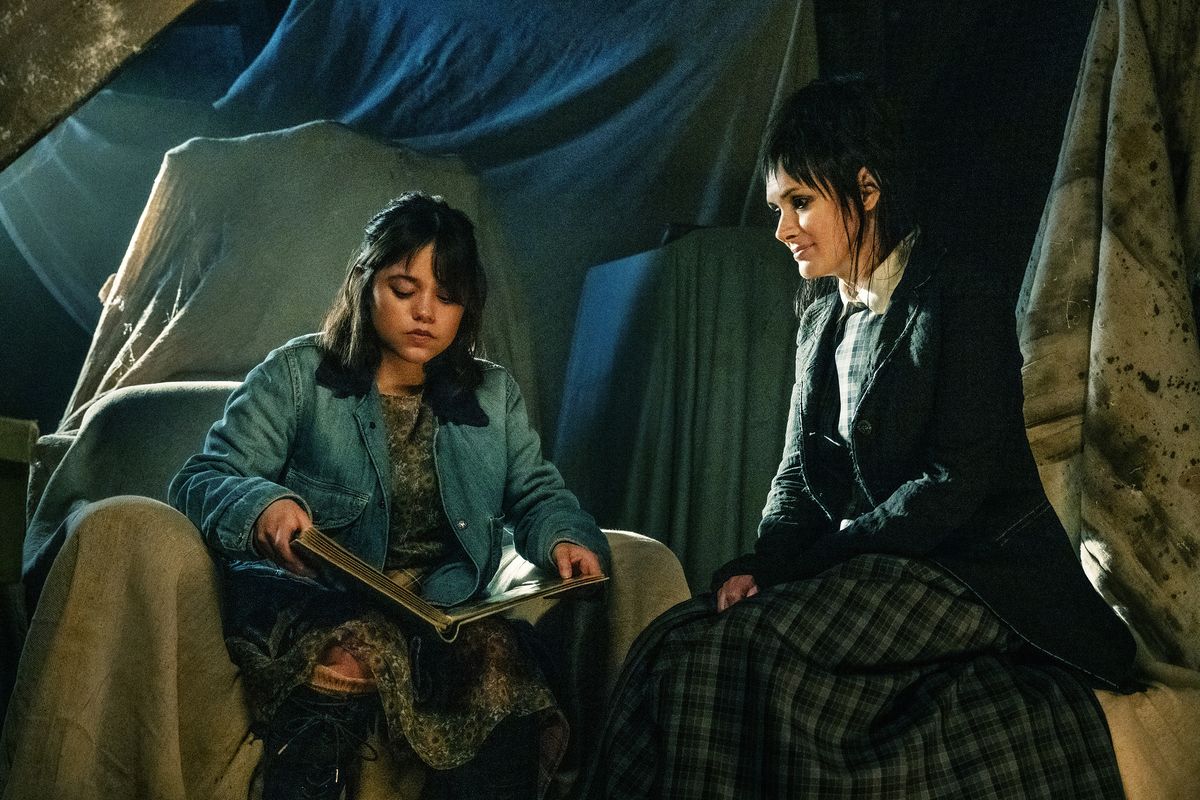Movie review: ‘Beetlejuice Beetlejuice’ is a mixed bag of recycled material

It’s hard to overstate the impact Tim Burton’s “Beetlejuice” had on the culture in 1988 – in fact, it feels like the rascally, wild-haired “bio-exorcist” memorably embodied by Michael Keaton has simply always been around, especially for a subset of millennials who grew up with the zany horror comedy on repeat. The Oscar-winning film was a critical and commercial success, it spawned an animated series and later a Broadway musical, and now 36 years after “Beetlejuice” made young Winona Ryder a star, a sequel, “Beetlejuice Beetlejuice,” finally skitters into theaters.
The idea of a follow-up to the hit film has long been bandied about, with scripts for “Beetlejuice in Love” and “Beetlejuice Goes Hawaiian” having been written, but it took three decades for something to come together, and this current cultural moment demands a “lega-sequel,” given the appetite for anything and everything nostalgic.
Unfortunately, “Beetlejuice” fans will have to abandon the leis and board shorts, because this long-awaited sequel takes place right back where we started, in Winter River, Connecticut (and the afterlife, of course). Ryder’s iconic character, Lydia Deetz – who defined quirky-Goth Gen X cool with her spiky bangs and sarcastic sense of humor – is now, like most women of her generation, a mom with a job. She hosts a paranormal talk show called “Ghost House,” and, karmically, struggles to parent a surly teen, Astrid (Jenna Ortega), who eye-rolls at mom’s new boyfriend, Rory (Justin Theroux), her producer, who is obsessed with overly sensitive therapy speak.
The Deetz women, including Lydia’s stepmother, conceptual artist Delia (Catherine O’Hara), are compelled to reconvene in Winter River upon the occasion of Lydia’s father Charles’ death. (Charles Deetz, played in the original film by Jeffrey Jones, is here rendered a particularly gruesome claymation death, by plane crash and shark attack, and his character wanders around the afterlife with his head and shoulders chomped off.)
While the original film is a wacky family comedy about death and real estate, “Beetlejuice Beetlejuice” attempts to be a bit more, stretching to find emotional resonance in what it means to connect with the dead. Astrid is a cynic who refuses to believe in ghosts, but when she has the opportunity to visit the afterlife, she jumps at it, simply because she misses her deceased father (Santiago Cabrera) so much. Lydia, tormented by visions of ghosts and sensing the presence of Beetlejuice close by, needs to make peace with her hauntings.
Speaking of the old boy, he’s got his own issues going on downstairs, namely an ex-wife (Monica Bellucci), stapled together and stalking him around his workplace, glowering beautifully. Bellucci’s stylish but underwritten role is indicative of some of the systemic issues that plague “Beetlejuice Beetlejuice,” which is, namely, too many celebrities. Certain roles are nothing more than glorified cameos (Danny DeVito) while others feel shoehorned in and distracting from the main plot (Willem Dafoe as a dead actor turned noir-ish afterlife detective).
After a first hour that feels somewhat forced and overly contrived, “Beetlejuice Beetlejuice” coheres for a brief moment in the middle, and we get to see some of the weird and wonderful chemistry that Ryder and Keaton still possess while inhabiting these characters. But the film then descends into hectic, harried chaos, as Burton and his “Wednesday” screenwriters Alfred Gough and Miles Millar (Seth Grahame-Smith has a “story by” credit) just toss characters, monsters and familiar set pieces into a blender and let it rip. Sandworms! Singing! Disco!
Watching “Beetlejuice Beetlejuice” is not an unpleasant experience, as it maintains a familiar irreverent tone, and a gorgeously morbid and imaginative look. The underworld is particularly well-designed, and Burton manages a blend of CGI and practical effects that maintains some of the charm of the original.
Certain qualities are undeniable, such as Keaton’s command of this character, O’Hara’s unique wit and the presence of Dafoe, who can elevate any project, no matter the role. Ryder has the heaviest performance lift, transitioning her character from teen to mom, but she finds her elder Lydia groove in the back half of the film.
But there’s something a bit bland and manufactured about this version, which doesn’t have the same hyperreal twisted suburban aesthetic that production designer Bo Welch brought to the original, as well as to Burton’s “Edward Scissorhands.” It doesn’t feel like a singular hand-crafted object, but rather like mass-produced Hot Topic merch for a new generation. It’s a busy, chaotic, mixed bag of recycled material that just leaves us wondering why we bothered summoning this project back from the dead in the first place.